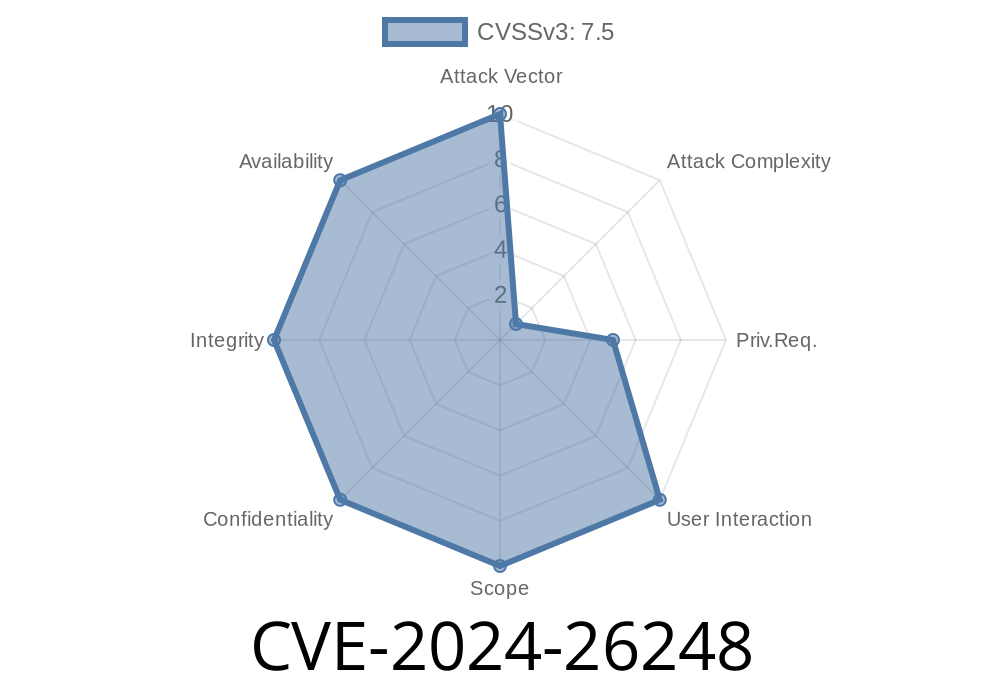In recent years, Microsoft Windows operating systems have been the primary target of malicious hackers, who are continually seeking new ways to exploit their vulnerabilities. One such vulnerability is CVE-2024-26248, a critical elevation of privilege vulnerability affecting the Windows Kerberos authentication mechanism. This vulnerability allows an attacker to impersonate any user on the domain and gain unauthorized access to sensitive data and system resources. In this post, we'll take a closer look at CVE-2024-26248, including the specifics of the exploit, code snippets demonstrating the vulnerability, and links to original references. Our goal is to provide a comprehensive understanding of this vulnerability so that security professionals and administrators may better protect their systems.
Exploit Details
CVE-2024-26248 is an elevation of privilege vulnerability affecting Microsoft's implementation of the Kerberos network authentication protocol. The vulnerability exists within the Kerberos Key Distribution Center (KDC) component, which plays a crucial role in the Kerberos infrastructure and is responsible for issuing tickets that allow users to authenticate themselves securely to various services within a domain.
The flaw allows an attacker to forge a valid Kerberos ticket by exploiting the KDC's failure to validate a specific field within the ticket – the Privilege Attribute Certificate (PAC) – correctly. By crafting a malicious PAC and combining it with a legitimate TGT (Ticket-Granting Ticket), an attacker can effectively trick the KDC into issuing a valid ticket with arbitrary privileges, ultimately allowing them to impersonate any user and access sensitive data and system resources.
It's important to note that exploiting CVE-2024-26248 requires the attacker to have network access to the target domain controller and, in most cases, credentials from a legitimate domain user.
Code Snippet
Here's a high-level pseudocode representation of the flawed PAC validation process within the Kerberos KDC component:
Function process_ticket_request(request):
tgt = request.ticket
pac = decode_pac(tgt.pac_data)
// The issue lies here: the KDC doesn't validate the PAC origin.
if not validate_pac_origin(pac):
return error("Invalid PAC")
service_ticket = generate_service_ticket(pac.user)
return service_ticket
The following Python code snippet demonstrates how an attacker may exploit the vulnerability
import kerberos
# Attacker's legitimate user credentials
username = "attacker"
password = "P@sswRd!"
domain = "victim-domain.com"
# Connect to the victim's domain controller
kdc = kerberos.connect(domain)
# Authenticate using the attacker's credentials
tgt = kdc.authenticate(username, password)
# Craft a malicious PAC
malicious_pac = kerberos.create_malicious_pac(tgt)
# Use the malicious PAC to obtain a forged service ticket
service_ticket = kdc.request_service_ticket(tgt, malicious_pac)
# Use the forged service ticket to access sensitive resources
kerberos.access_resources(service_ticket)
To mitigate this vulnerability, Microsoft has released patches as part of their monthly security updates. To protect your environment, it's essential to apply these updates and keep your systems up to date.
Original References
1. Microsoft Security Response Center (MSRC) - CVE-2024-26248: https://msrc.microsoft.com/update-guide/vulnerability/CVE-2024-26248
2. MITRE CVE Details - CVE-2024-26248: https://cve.mitre.org/cgi-bin/cvename.cgi?name=CVE-2024-26248
3. National Vulnerability Database (NVD) - CVE-2024-26248: https://nvd.nist.gov/vuln/detail/CVE-2024-26248
Conclusion
CVE-2024-26248 is a critical vulnerability affecting the Windows Kerberos authentication mechanism, allowing attackers to gain unauthorized access to sensitive data and system resources. This post has provided an in-depth look at the vulnerability, including code snippets, exploitation details, and links to original references. By understanding how this vulnerability works and keeping systems up to date, security professionals and administrators can better protect their networks and users against potential attacks.
Timeline
Published on: 04/09/2024 17:15:46 UTC
Last modified on: 04/10/2024 13:24:00 UTC
